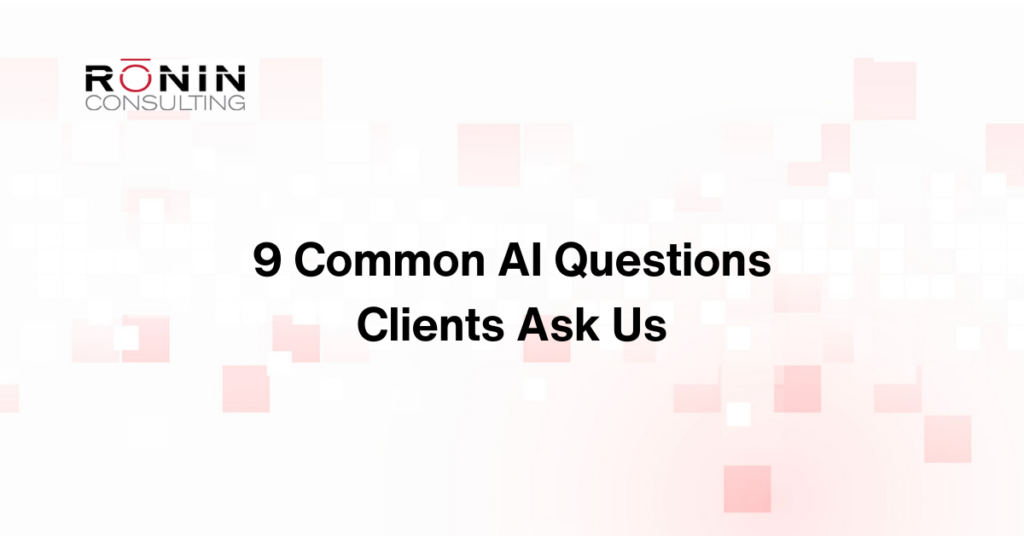
AI has moved beyond R&D; it now plays a central role in shaping enterprise strategy. As more leaders work to integrate AI into their workflows, the pace of innovation raises even more urgent questions.
At Rōnin Consulting, clients ask these common AI questions weekly, so we pulled together the nine most asked ones. Whether launching your first proof of concept or refining your AI-enabled workflow, this guide answers some of the most pressing questions, such as:
- Should you use a large language model (LLM) or traditional machine learning (ML)?
- How do you measure ROI on a generative AI project?
- Should you be worried about data security and compliance with AI?
- How fast can you deploy AI and see value?
- How do you estimate token costs for AI projects?
- How do you choose the right AI model for your project?
- Do you have to use your cloud vendor’s model for your AI project?
- Which cloud vendor is right for AI integration?
- Do you need a RAG pipeline (Retrieval-Augmented Generation)?
Answers to these questions are not just technical choices; they’re strategic moves. Get them right, and your AI initiative delivers real, lasting impact. Get them wrong, and your momentum could stall.
In the sections ahead, we break down these questions and guide you from curiosity to confidence in the next phase of your AI implementation.
Should you use a large language model (LLM) or traditional machine learning (ML)?
This is one of the most critical early decisions in any AI journey. It affects how you approach your data, what problems you can solve, and how much your solution will cost. In short, we like to break it up this way:
- Use an LLM when your project requires natural language understanding, summarization, classification, content generation, or knowledge extraction.
- Use traditional ML when working with structured data, like spreadsheets or databases, and need predictive models (e.g., sales forecasting or churn prediction).
Pro tip: Many successful enterprise solutions combine both. They use LLMs to handle unstructured user input and ML to handle structured, backend decision-making.
How do you measure ROI on a generative AI project?
You can’t manage what you don’t measure. And without proving the business impact, AI initiatives quickly lose support. However, ROI will take time, so it’s best to take a bird’s-eye view of your entire project and (depending on how you implement your AI) track results across these three pillars:
- Efficiency gains: Are you saving time and/or reducing labor costs through automation?
- Revenue impact: Is AI driving more conversions, increasing upsell potential, or enabling new offerings?
- Risk reduction: Has AI helped reduce human error, improve compliance, or respond to customers faster?
Avoid hype metrics that say little about real-world value, such as flashy numbers like model size or benchmark accuracy. Use real outcomes to gain buy-in and to justify scaling. Track the metrics related to the problem you want AI to solve. Measuring the issue first gives you a solid foundation to build from.
Should you be worried about data security and compliance with AI?
Yes, and you should plan for it early. Trust drives adoption, and that trust depends on how well you protect your data.
We recommend:
- Preventing training misuse: Make sure your data isn’t being used to train third-party models. Enterprise agreements can help with this.
- Securing your infrastructure: Use private endpoints, encryption, audit logging, and strict access control.
- Consider on-premises: For highly sensitive environments, deploying models on-premises offers full control.
Bottom line: Own your data and protect your systems. Prioritizing security early can also help you avoid unexpected compliance headaches down the line.
How fast can you deploy AI and see value?
This is a complicated question, and the answer varies depending on the project. Speed to value matters, but rushing can derail long-term success. To approach this, take a phased approach:
- Launch a pilot MVP within 6–12 weeks to prove the concept.
- Start small. Focus on low-risk use cases that deliver quick wins.
- Scale deliberately using real-world results to inform the changes.
Start with quick wins; they build trust and momentum. Double down on what’s working. If it’s not, shift gears and refocus.
How do you estimate token costs for AI projects?
Generative AI models charge based on tokens the model reads and generates. If you’re not careful, costs can escalate fast.
Watch for:
- Model size: Model size can vary depending on the project. For reasoning models, there’s typically a “reasoning effort” setting, like low, medium, or high, which affects how many tokens the model uses. Higher effort means more tokens and less predictability in output length. We usually control the “max completion tokens” setting to manage this. This sets an upper limit and helps prevent the model from going off the rails, but it can also cut off longer responses. So, the right choice depends on the project’s goals and prompt length.
- Prompt length: Bigger queries and responses = more tokens = higher costs.
- Usage volume: Frequent usage across teams can multiply your monthly bill.
To pick the right model and understand your likely costs, test early. Run simulations during a pilot phase to forecast and manage budget expectations.
Pro tip: Work with an agency that’s been through this before. A seasoned consulting partner can help you choose the right model, steer you away from wasteful usage, and guide you toward cost-effective options; including newer models or fine-tuning strategies that fit your budget.
How do you choose the right AI model for your project?
There are so many models out there, the choices can be overwhelming. The best approach is to define what success looks like for your project, then work with your agency to select a model that fits your business needs and technical requirements. Your goals, constraints, and data will shape the right model. A good place to start is to evaluate options based on:
- Data sensitivity: If you’re in a regulated industry (e.g., healthcare, finance), consider open-source or self-hosted models for better control and compliance.
- Performance needs: Latency, accuracy, and uptime can vary widely between models. Choose what aligns with your user experience goals.
- Budget: Larger or proprietary models (like GPT-4) often deliver better performance but come with a higher price tag.
- Adaptability: Some models are easier to fine-tune or integrate into your workflow, especially if your use case is highly specialized.
- Vendor lock-in: Flexibility matters. Choose models or platforms that won’t box you in long-term if priorities shift.
There’s no one-size-fits-all model—just the one that aligns best with your priorities.
Do you have to use your cloud vendor’s model for your AI project?
No, but it’s often convenient. Cloud-native models (like Azure OpenAI or AWS Bedrock) offer seamless billing, scaling, and security. However, you can also:
- Bring your own model
- Deploy open-source models
- Use a hybrid approach to optimize performance and cost
You’re not locked in. If you’re using AWS and want to go all-in on ChatGPT, that’s totally valid. But in many cases, it’s easier (and more cost-effective) to stick with the ecosystem you’re already in. Switching later isn’t impossible, it’s just harder and more expensive than planning ahead.
Which cloud vendor is right for AI integration?
The cloud platform you choose can shape everything—from model access to scalability and governance.
Here’s a simplified comparison:
- Azure: Great for companies already using Microsoft. It offers direct access to OpenAI models and native integration with Office 365 tools.
- AWS: Offers maximum flexibility and a wide range of model options through Bedrock.
- Google Cloud: Known for AI research leadership and Vertex AI; ideal for teams already invested in Google’s ecosystem.
Match the vendor to your internal tooling and team preferences, and you will save time and money down the road.
Do you need a RAG pipeline (Retrieval-Augmented Generation)?
If your AI needs to provide up-to-date, personalized, or domain-specific information, then yes, a RAG pipeline is essential. RAG enables your LLM to “look up” relevant data at query time, without retraining the entire model. This approach is:
- More accurate for enterprise-specific use cases
- Lower cost than frequent fine-tuning
- Easier to maintain with real-time updates
As your knowledge base grows, RAG becomes not just helpful, but foundational. Don’t skip this necessary tool; incorporate it from day one if you can.
Next steps for AI-ready leaders
Generative AI will provide business value, but only if leaders approach it with clarity and purpose. This list doesn’t cover every question we hear, but it captures the key considerations leaders need to address when planning AI integration.
At Rōnin Consulting, we work with organizations to design and deploy AI solutions that align with their business objectives, technical environment, and compliance requirements. AI demands clear vision and strategic alignment, not just experimentation, and that’s what we’re here to help with. If you’re assessing how AI fits into your long-term strategy, we’re here to help you take the next step with confidence.
Want More Content Like This?
Join the Rōnin Recap
Get expert insights on AI, integration, and the future of software — direct from the team at Rōnin Consulting. We’ll send you the good stuff, not spam.





